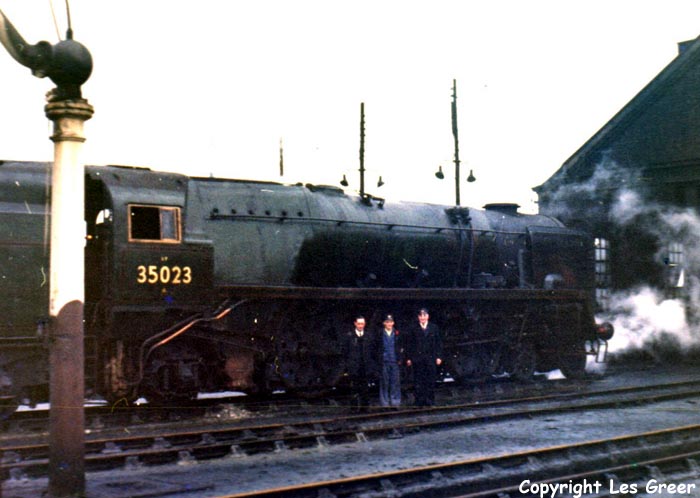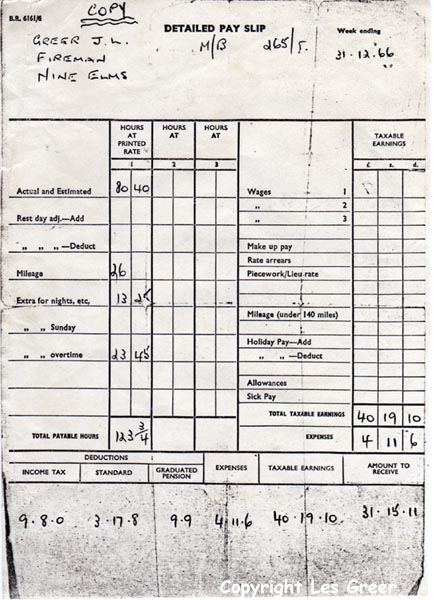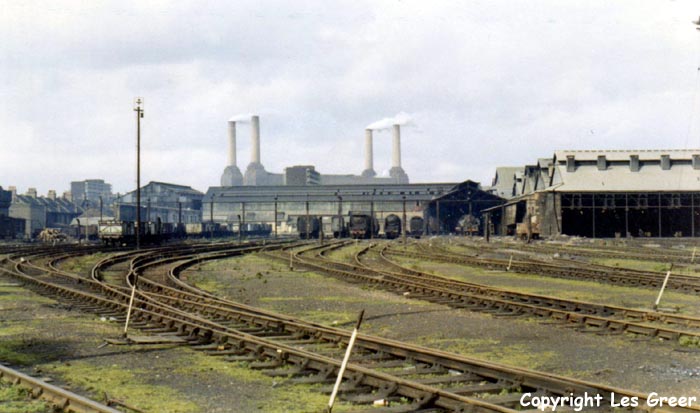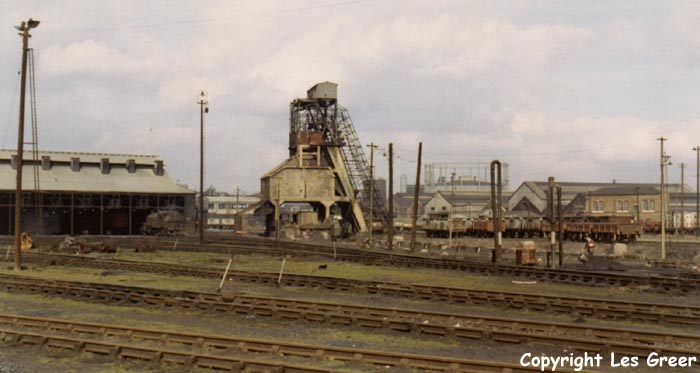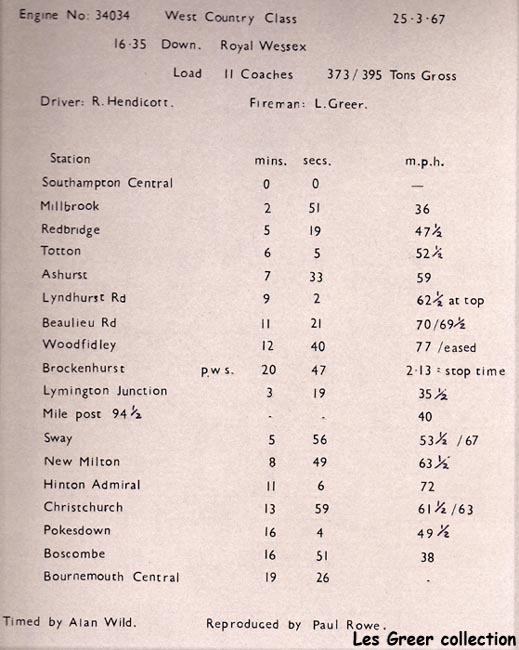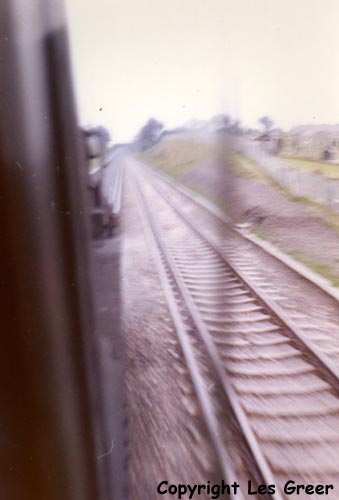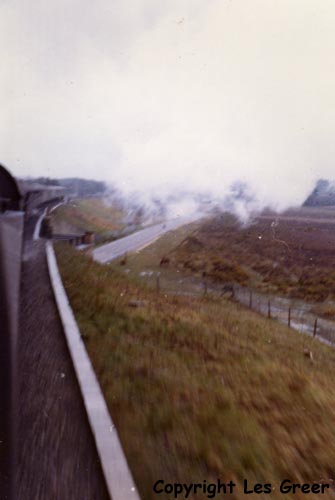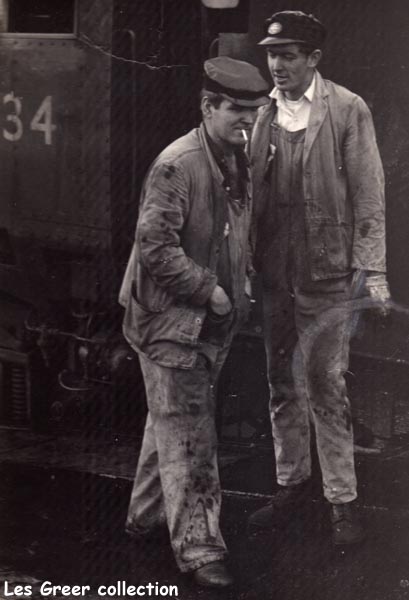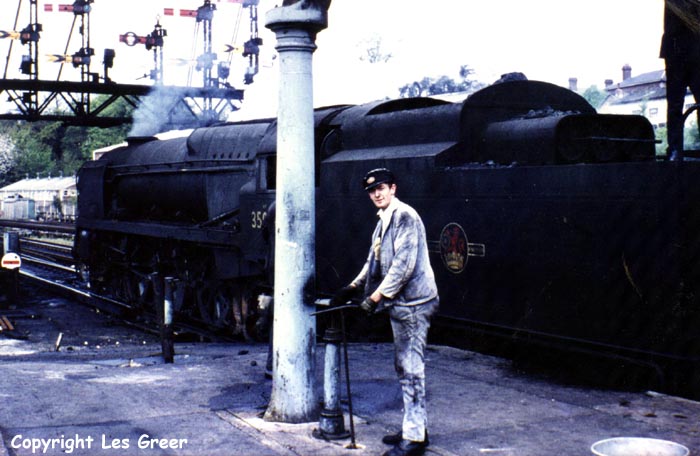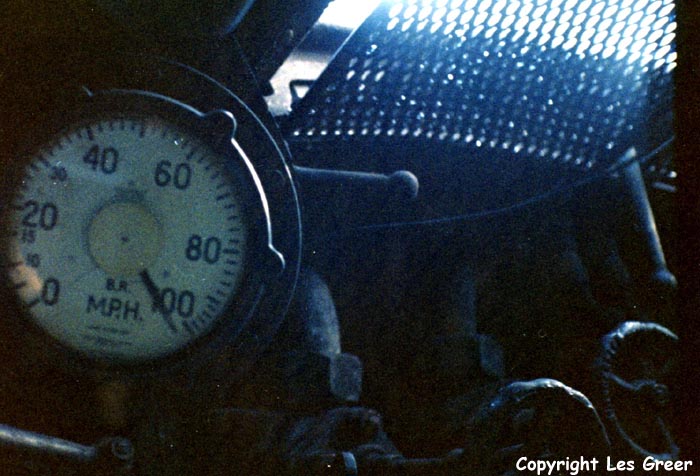
STEAM'S LAST GASPI started on the footplate at Edge Hill, Liverpool and transferred to Willesden to become a registered fireman. When steam finished at Willesden in September 1965 I moved to Banbury Shed in January 1966. Steam finished at Banbury in September 1966 but the shed was still operational for steam and a special was booked with 7029 "Clun Castle" and Merchant Navy Class 35023 "Holland-Afrika Line" in late October. A chance conversation on the shed with Southern Locomotive Inspector Tim Crowley resulted in my going on loan to Nine Elms Depot in mid November 1966.
At first I was put in No. 4 link with Driver Gordon Porter but after two weeks I was moved to No. 3 passenger link with Driver Jim Twyman who was my regular mate for the duration. In early December I was in the time office when a voice said "Hello Les". I turned round and it was Dave May, a friend of mine who had been a fireman at Willesden with me. I replied that "I knew it wouldn't be long before you appeared" and he answered "Yes and Steve Cave is coming down here in January". Steve Cave, now a driver for Central Trains, was also at Willesden. We were like railway mercenaries who followed the steam about. In all twelve men came on loan from the London Midland Region. On Wednesday 28th. December, 1966 someone dropped a locomotive into the turntable pit. The result was that the foreman asked Dave May and myself to look after the points at the shed entrance and turn all locos coming on shed round the triangle. He also said "Stay there as long as you want". A fatal remark! We set up a watchman's cabin and a brazier and got a good supply of food. I vividly remember watching the 02.40 a.m. newspaper train storm past with an unmodified pacific (probably 34057), bouncing red hot cinders off the last coach roof. After seventeen hours we decided to go home.
A job I did in No. 4 link was down with the 07.18 local to Woking then passenger (that is travel on the cushions) to Basingstoke and work a local back to Waterloo. On 23rd. February, 1967 Peter Giles and I worked this turn with BR Standard Class 4 No. 75068. The engine was not steaming, the fire got worse as we progressed and once beyond Byfleet on Brookwood bank we knew we were going to stop. Just past West Byfleet we ground to a halt with no steam, very little water and a fire that was more like treacle than coal. The guard came up and ascertained the situation and went back to his brake, he and Peter both seemed very laid back about it. We blew the boiler round and were off again a few minutes later and arrived in Woking too late to pick up our return working at Basingstoke. We were told that we should wait and relieve the train at Woking. The train arrived and the men got off straight away (always a bad sign). The driver came up to me and said "Sorry mate he's only a cleaner". When we got on the engine it had 120 lbs of steam and an inch of water in the bottom of the glass and the guard was waving his flag for us to go. I said to Peter "where would you like to stop going back?" He laughed but in the event the engine steamed very well and we were soon on top of the job. Another example of a set of men getting off an engine early when being relieved was at Eastleigh Yard on 10th. March, 1967. The job was the 17.45 Express Passenger to Southampton then work the 20.18 parcels from Eastleigh yard to Clapham Yard. Fred Domm was the driver and we got relief at Southampton then travelled to Eastleigh. As we walked towards BR Standard Class 4 No. 75075 we saw the men get off and walk quickly past us. A quick confirmation that they were relieved and they were away. On getting on the loco I found the fire was heavily clinkered and generally in a poor state. As I was cleaning the fire the guard came up and gave Fred the load. 17on for 451 tons! Fred immediately asked me if I wanted to take them because as he put it "you are going to do the work". Always liking a challenge (idiot) I said "Yes we'll take them". We set off and it was very hard work . We just about managed to get over the summit at Roundwood and limped down through Basingstoke. On the easier grades after Basingstoke we made better progress and got to Clapham on time.
The Vauxhall Milk was a very nice job. You would book on duty at 22.30 and get an engine ready on shed then go to Clapham and pick up the milk train at about midnight. Arriving at Vauxhall on the Windsor side you would park the train in the platform at about 01.30. You would then get the boiler filled up and the fire damped down as you would not move again until 06.30. There were some old first class compartment cushions kept at the station and these would be spread on the footplate to ensure a good nights rest.
A notable occasion was on 9th. March, 1967 when Bill Anderson and I worked the 16.35 Royal Wessex down to Bournemouth and back with the last up Weymouth departing at 19.38 from Bournemouth. We had Brush type 4 D1922 down and West Country No. 34087 "145 Squadron " Up. On the return we were joined by two unofficial footplate passengers, Tony Lever and Les Kent who were two well known enthusiasts on the south western main line. It was a matter of pride to attempt to beat the record of the highest speed over the summit at Roundwood which at that time stood at 70 m.p.h. with a standing start from Winchester. We set off from Winchester and went for the record, 34087 was performing well and by the time we reached Micheldever I had finished firing for the bank. Tony asked me if he could put a few shovelfulls on and I said Yes. He picked up the shovel and I watched him as he put the first shovelfull into the firehole. At that precise moment we hit Popham tunnel and with such a fierce blast the tunnel caused an immediate blowback. The cab was filled with flames that hit the tender, immediately I dropped the butterfly doors shut and slammed the blower wide open. At the same time Bill had shut the regulator and applied a full brake application. No sooner had he done so Tony grabbed his arm and screamed "Blow up, Blow up, I'm OK". Bill released the brake before it had time to act and opened the regulator to full second valve. These events happened very quickly but in spite this we achieved 85mph over Roundwood summit! Tony and Les got off at Woking as we never took any passengers into Waterloo. At Waterloo Tony came and thanked us for the record and he had his hair singed, no eyebrows and a blister the size of a half crown (ten pence piece) on each cheek. A few days later I was on the station pilot at Waterloo and Bill was on a Salisbury. He came across to see me and said that Tony had had to go to hospital and that he would never again take any passengers on the footplate. Tony recovered well and I met him some years later and we now keep in touch. This run is documented in performance table No. 70 page 221 of D. W. Winkworth's book entitled Bullied's Pacifics. On 25th. March, 1967 Ruben Hendicott and I worked the 16.35 Royal Wessex from Waterloo. It is normally a Brush type 4 diesel for the down journey to Bournemouth and a pacific on the return. This particular day the motive power was reversed with No. 34034" Honiton" on the down trip and Brush type 4 D1921 on the return. 34034 was in very good condition and with a load of 11 for 437 tons climbed from Southampton to Woodfidley in 12 minutes and 40 seconds and was eased back from 77 mph for a p.way slack. A log of the run is produced and was timed by Alan Wild.
On 27th. March, 1967 Eddy Ball and I had been to Morden and worked some tanks back to Clapham Yard. We were then told to go to Waterloo and relieve a set of Feltham men off an up express when it arrived. We waited at the cabin at the top of platform 10 and were told that it was by Clapham. After half an hour we were wondering where it was and enquired again. We were told it was near Vauxhall. A further half an hour passed and we then learned that the engine had failed just outside the station and the station pilot was going to drag it into Waterloo. It arrived in Platform 14 and the Feltham driver explained that he had had lots of problems with engine No. 35030 Elder Dempster Lines. On getting on the footplate we found the water very low in the glass, 100 lbs of steam, very little fire in the box and water cascading down the front of the firebox. Eddy said "What do you reckon? I said "Drop it immediately". I then got off the engine and opened the ashpan climbed back on the footplate and dropped what was left of the fire at the bottom of platform 14. After the empty stock had been removed a Brush type 4 diesel came to drag us to the shed. Whilst I was attaching the diesel Eddy was on the platform talking to the diesel driver and he said to me "Don't bother with the bag". I answered that it wasn't a problem as I had it in my hand so I coupled it up. When we left the platform there were lots of bangs and flashes where the ashpan hopper door that I had left open was catching the live rail. Eddy put on the brakes which stopped the diesel immediately with the vacuum. I got down and closed the hopper door and we then were dragged back to the shed. Another incident was when Jim Twyman and I were down with the 08.35 to Bournemouth and back with the fast. It was 24th. April, 1967 and the engine was No. 35028 Clan Line. We had a Bournemouth driver riding with us learning the road from Waterloo. Everything went normally until we got stopped at New Milton. I got on the telephone and the signalman said that there was a reported body on the up line near Hinton Admiral and would we examine the opposite running line. The signalman also stated that he would block the Up line until we reported back to him. I reported this to Jim and we set off. On the down gradient approaching Hinton Admiral we found the body and stopped. Jim and I removed the body of a ganger from the live rail. We reported this and carried on to Bournemouth. We were later summoned to a court of enquiry at Bournemouth Area Manager's office on the 5th. May, 1967. This involved us travelling to Bournemouth on our rest day dressed in civvy clothes and a good lunch on expenses.
The enthusiast could be very useful on occasions. On 29th. April, 1967 Jim Twyman and I had to work the Saturday morning down 08.30 to Bournemouth. The locomotive was 34025 with a load of ten coaches for 350 tons. All was going very well and Jim decided to stretch the loco's legs down Winchester bank. We achieved 106mph before Jim shut off approaching Eastleigh.
All too soon the party was over and on Sunday 2nd. July Dave May and Driver Bruv Mercer took 35028 out of Waterloo for the last time on the Southern Regions 'Farewell to Steam' trip.
Copyright 2007 © Les Greer - Nine Elms - Southern Engineman
Light to Loco (return to Nine Elms Index)
|
|
Site sponsored/maintained by SVSFilm © 2007 ... Go to SVS Film Index Go to Nine Elms Main Index - "Light to Loco" |
